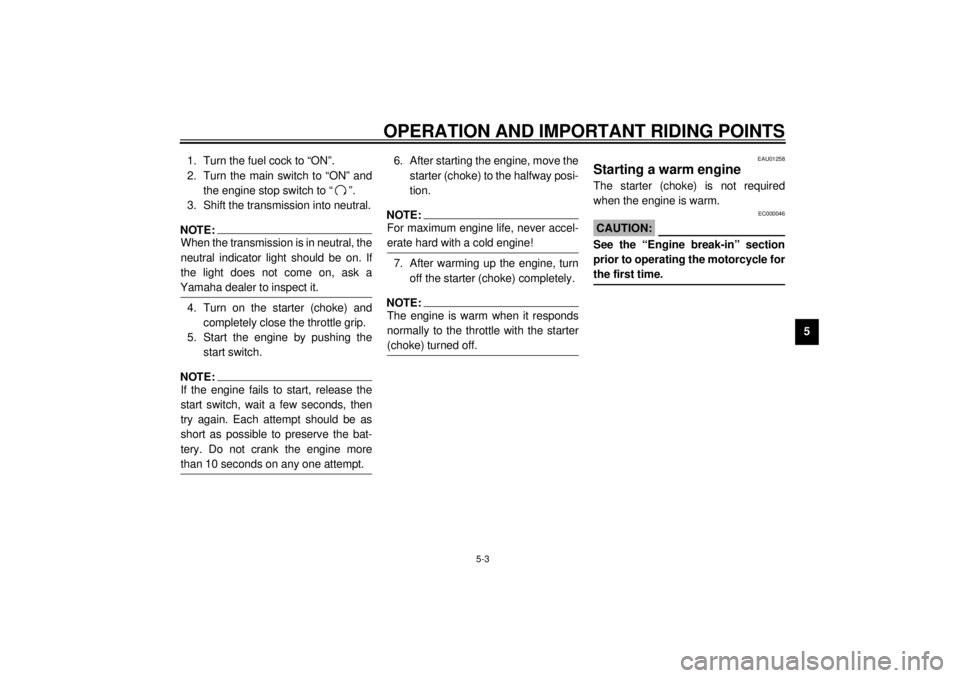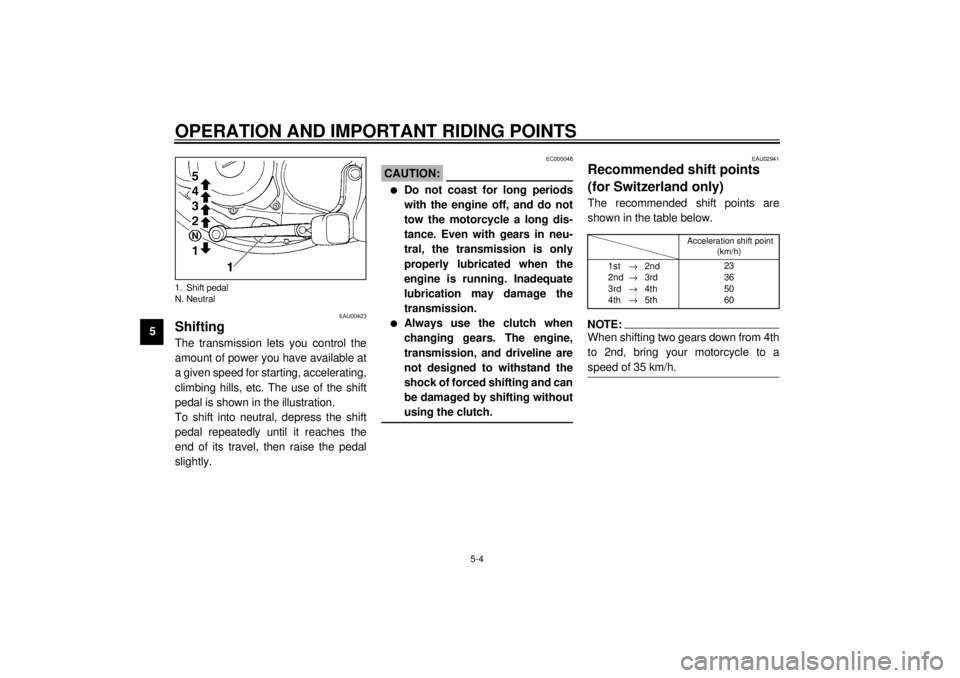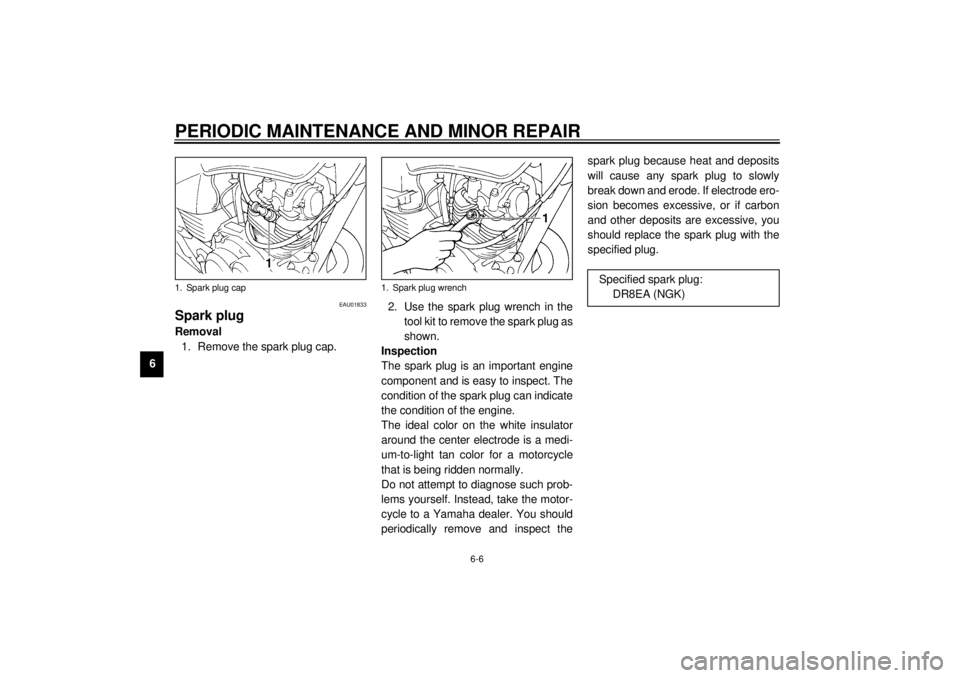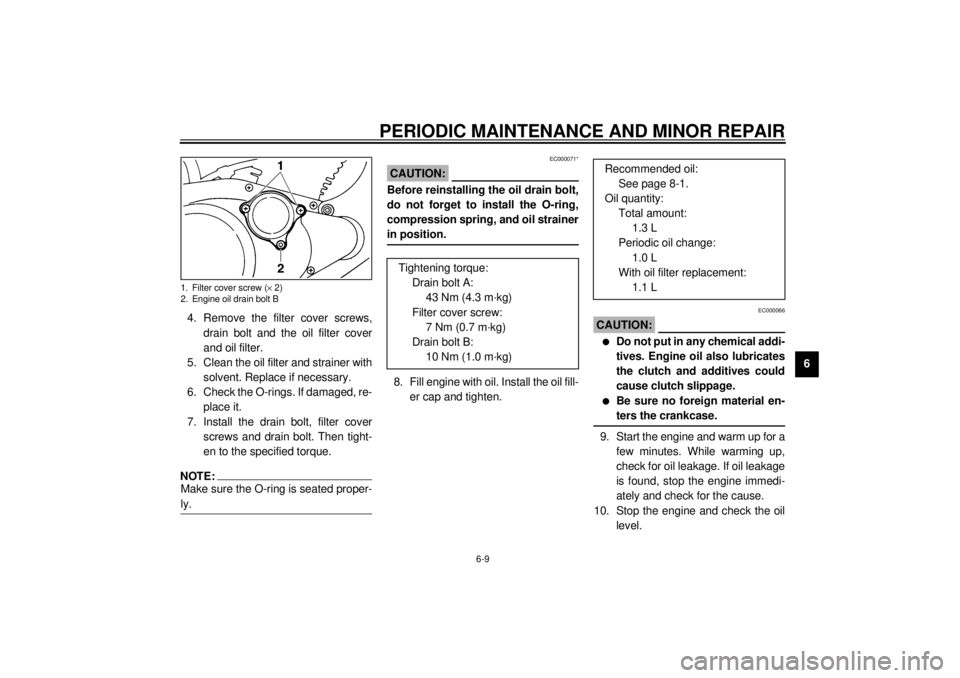engine YAMAHA SR125 2000 User Guide
[x] Cancel search | Manufacturer: YAMAHA, Model Year: 2000, Model line: SR125, Model: YAMAHA SR125 2000Pages: 78, PDF Size: 8.59 MB
Page 26 of 78

OPERATION AND IMPORTANT RIDING POINTS
5-2
5
CF-31E
TURN THE MAIN SWITCH TO "ON" AND THE
ENGINE STOP SWITCH TO “ ”.
IF THE TRANSMISSION IS IN NEUTRAL AND THE
SIDESTAND IS DOWN,PUSH START SWITCH.
THE ENGINE WILL START.RETRACT THE SIDESTAND AND PUT THE
TRANSMISSION IN GEAR.
IF THE TRANSMISSION IS IN GEAR AND THE
SIDESTAND IS UP,PULL IN THE CLUTCH LEVER AND PUSH THE
START SWITCH. THE ENGINE WILL START.
THE MOTORCYCLE CAN BE RIDDEN.
THE MOTORCYCLE CAN BE RIDDEN.
E_3mw.book Page 2 Monday, February 5, 2001 9:54 AM
Page 27 of 78

OPERATION AND IMPORTANT RIDING POINTS
5-3
5 1. Turn the fuel cock to “ON”.
2. Turn the main switch to “ON” and
the engine stop switch to “ ”.
3. Shift the transmission into neutral.
NOTE:@ When the transmission is in neutral, the
neutral indicator light should be on. If
the light does not come on, ask a
Yamaha dealer to inspect it. @4. Turn on the starter (choke) and
completely close the throttle grip.
5. Start the engine by pushing the
start switch.NOTE:@ If the engine fails to start, release the
start switch, wait a few seconds, then
try again. Each attempt should be as
short as possible to preserve the bat-
tery. Do not crank the engine more
than 10 seconds on any one attempt. @
6. After starting the engine, move the
starter (choke) to the halfway posi-
tion.NOTE:@ For maximum engine life, never accel-
erate hard with a cold engine! @7. After warming up the engine, turn
off the starter (choke) completely.NOTE:@ The engine is warm when it responds
normally to the throttle with the starter
(choke) turned off. @
EAU01258
Starting a warm engineThe starter (choke) is not required
when the engine is warm.
EC000046
CAUTION:@ See the “Engine break-in” section
prior to operating the motorcycle for
the first time. @
E_3mw.book Page 3 Monday, February 5, 2001 9:54 AM
Page 28 of 78

OPERATION AND IMPORTANT RIDING POINTS
5-4
5
EAU00423
ShiftingThe transmission lets you control the
amount of power you have available at
a given speed for starting, accelerating,
climbing hills, etc. The use of the shift
pedal is shown in the illustration.
To shift into neutral, depress the shift
pedal repeatedly until it reaches the
end of its travel, then raise the pedal
slightly.
EC000048
CAUTION:@ l
Do not coast for long periods
with the engine off, and do not
tow the motorcycle a long dis-
tance. Even with gears in neu-
tral, the transmission is only
properly lubricated when the
engine is running. Inadequate
lubrication may damage the
transmission.
l
Always use the clutch when
changing gears. The engine,
transmission, and driveline are
not designed to withstand the
shock of forced shifting and can
be damaged by shifting without
using the clutch.
@
EAU02941
Recommended shift points
(for Switzerland only)The recommended shift points are
shown in the table below.CF-25ENOTE:@ When shifting two gears down from 4th
to 2nd, bring your motorcycle to a
speed of 35 km/h. @
1. Shift pedal
N. Neutral
Acceleration shift point
(km/h)
1st®2nd
2nd®3rd
3rd®4th
4th®5th23
36
50
60
E_3mw.book Page 4 Monday, February 5, 2001 9:54 AM
Page 29 of 78

OPERATION AND IMPORTANT RIDING POINTS
5-5
5
EAU00424
Tips for reducing fuel
consumptionYour motorcycle’s fuel consumption
depends to a large extent on your
riding style. The following tips can help
reduce fuel consumption:l
Warm up the engine before riding.
l
Turn off the starter (choke) as
soon as possible.
l
Shift up swiftly and avoid high en-
gine speeds during acceleration.
l
Do not double-clutch or rev the en-
gine while shifting down and avoid
high engine speeds with no load
on the engine.
l
Turn off the engine instead of let-
ting it idle for an extended length
of time, i.e. in traffic jams, at traffic
lights or railroad crossings.
EAU00436
Engine break-inThere is never a more important period
in the life of your motorcycle than the
period between zero and 1,000 km. For
this reason we ask that you carefully
read the following material. Because
the engine is brand new, you must not
put an excessive load on it for the first
1,000 km. The various parts in the en-
gine wear and polish themselves to the
correct operating clearances. During
this period, prolonged full throttle oper-
ation, or any condition which might re-
sult in excessive heating of the engine,
must be avoided.
E_3mw.book Page 5 Monday, February 5, 2001 9:54 AM
Page 30 of 78

OPERATION AND IMPORTANT RIDING POINTS
5-6
5
EAU00438
0 ~ 150 km
Avoid operation above 1/3 throttle.
Stop the engine and let it cool for 5 to
10 minutes after every hour of opera-
tion. Vary the speed of the motorcycle
from time to time. Do not operate it at
one set throttle position.
150 ~ 500 km
Avoid prolonged operation above
1/2 throttle.
500 ~ 1,000 km
Avoid cruising speeds in excess of
3/4 throttle.
EC000050
CAUTION:@ After 1,000 km of operation, be sure
to replace the engine oil. @
1,000 km and beyond
Avoid prolonged full-throttle operation.
Vary speed occasionally.
EC000049
CAUTION:@ If any engine trouble should occur
during the break-in period, consult a
Yamaha dealer immediately. @
EAU00457
ParkingWhen parking the motorcycle, stop the
engine and remove the ignition key.
Turn the fuel cock to “OFF” whenever
stopping the engine.
EW000058
WARNING
@ The exhaust system is hot. Park the
motorcycle in a place where pedes-
trians or children are not likely to
touch the motorcycle. Do not park
the motorcycle on a slope or soft
ground; the motorcycle may over-
turn. @
E_3mw.book Page 6 Monday, February 5, 2001 9:54 AM
Page 33 of 78

PERIODIC MAINTENANCE AND MINOR REPAIR
6-3
6
10
*Wheels• Check runout, spoke tightness and for damage.
• Tighten spokes if necessary.ÖÖÖÖ
11*Tires• Check tread depth and for damage.
• Replace if necessary.
• Check air pressure.
• Correct if necessary.ÖÖÖÖ
12*Wheel bearings• Check bearing for looseness or damage.ÖÖÖÖ
13*Swingarm• Check operation and for excessive play.ÖÖÖÖ
14 Drive chain• Check chain slack.
• Make sure that the rear wheel is properly aligned.
• Clean and lubricate.Every 1,000 km and after washing
the motorcycle or riding in the rain.
15*Steering bearings• Check bearing play and steering for roughness.ÖÖÖÖÖ
• Lubricate with lithium-soap-based grease. Every 24,000 km
16*Chassis fasteners• Make sure that all nuts, bolts and screws are properly tightened.ÖÖÖÖ Ö
17 Sidestand, centerstand• Check operation.
• Lubricate.ÖÖÖÖ Ö
18*Sidestand switch• Check operation.ÖÖÖÖÖ Ö
19*Front fork• Check operation and for oil leakage.ÖÖÖÖ
20*Shock absorber
assemblies• Check operation and shock absorbers for oil leakage.ÖÖÖÖ
21*Carburetor• Check starter (choke) operation.
• Adjust engine idling speed.ÖÖÖÖÖ Ö
22 Engine oil• Change.ÖÖÖÖÖ Ö
23 Engine oil filter element•Clean.ÖÖÖ
24*Front and rear brake
switches• Check operation.ÖÖÖÖÖ Ö
25 Moving parts and cables• Lubricate.ÖÖÖÖ Ö NO. ITEM CHECK OR MAINTENANCE JOBODOMETER READING (´1,000 km)
ANNUAL
CHECK
1 6 12 18 24
E_3mw.book Page 3 Monday, February 5, 2001 9:54 AM
Page 36 of 78

PERIODIC MAINTENANCE AND MINOR REPAIR
6-6
6
EAU01833
Spark plugRemoval
1. Remove the spark plug cap.2. Use the spark plug wrench in the
tool kit to remove the spark plug as
shown.
Inspection
The spark plug is an important engine
component and is easy to inspect. The
condition of the spark plug can indicate
the condition of the engine.
The ideal color on the white insulator
around the center electrode is a medi-
um-to-light tan color for a motorcycle
that is being ridden normally.
Do not attempt to diagnose such prob-
lems yourself. Instead, take the motor-
cycle to a Yamaha dealer. You should
periodically remove and inspect thespark plug because heat and deposits
will cause any spark plug to slowly
break down and erode. If electrode ero-
sion becomes excessive, or if carbon
and other deposits are excessive, you
should replace the spark plug with the
specified plug.1. Spark plug cap
1. Spark plug wrench
Specified spark plug:
DR8EA (NGK)
E_3mw.book Page 6 Monday, February 5, 2001 9:54 AM
Page 38 of 78

PERIODIC MAINTENANCE AND MINOR REPAIR
6-8
6
EAU01093*
Engine oilOil level inspection
1. Place the motorcycle on the cen-
terstand. Warm up the engine for
several minutes.NOTE:@ Be sure the motorcycle is positioned
straight up when checking the oil level.
A slight tilt toward the side can result in
false readings. @
2. With the engine stopped, check
the oil level through the level win-
dow located at the lower part of
the right side crankcase cover.NOTE:@ Wait a few minutes until the oil level
settles before checking. @3. The oil level should be between
the maximum level and minimum
level marks. If the level is low, fill
the engine with sufficient oil to
raise it to the specified level.Engine oil replacement and oil filter
element cleaning
1. Warm up the engine for a few min-
utes.
2. Stop the engine. Place an oil pan
under the engine and remove the
oil filler cap.
3. Remove the drain bolt and drain
the oil.
EC000070*
CAUTION:@ When removing the oil drain bolt,
the O-ring, compression spring, and
oil strainer will fall out. Take care not
to lose these parts. @
1. Oil level window
2. Maximum level mark
3. Minimum level mark
1. Engine oil drain bolt A
E_3mw.book Page 8 Monday, February 5, 2001 9:54 AM
Page 39 of 78

PERIODIC MAINTENANCE AND MINOR REPAIR
6-9
6 4. Remove the filter cover screws,
drain bolt and the oil filter cover
and oil filter.
5. Clean the oil filter and strainer with
solvent. Replace if necessary.
6. Check the O-rings. If damaged, re-
place it.
7. Install the drain bolt, filter cover
screws and drain bolt. Then tight-
en to the specified torque.
NOTE:@ Make sure the O-ring is seated proper-
ly. @
EC000071*
CAUTION:@ Before reinstalling the oil drain bolt,
do not forget to install the O-ring,
compression spring, and oil strainer
in position. @8. Fill engine with oil. Install the oil fill-
er cap and tighten.
EC000066
CAUTION:@ l
Do not put in any chemical addi-
tives. Engine oil also lubricates
the clutch and additives could
cause clutch slippage.
l
Be sure no foreign material en-
ters the crankcase.
@9. Start the engine and warm up for a
few minutes. While warming up,
check for oil leakage. If oil leakage
is found, stop the engine immedi-
ately and check for the cause.
10. Stop the engine and check the oil
level.
1. Filter cover screw (´ 2)
2. Engine oil drain bolt B
Tightening torque:
Drain bolt A:
43 Nm (4.3 m·kg)
Filter cover screw:
7 Nm (0.7 m·kg)
Drain bolt B:
10 Nm (1.0 m·kg)
Recommended oil:
See page 8-1.
Oil quantity:
Total amount:
1.3 L
Periodic oil change:
1.0 L
With oil filter replacement:
1.1 L
E_3mw.book Page 9 Monday, February 5, 2001 9:54 AM
Page 40 of 78

PERIODIC MAINTENANCE AND MINOR REPAIR
6-10
6
EAU01094
Air filterThe air filter should be cleaned at the
specified intervals. It should be cleaned
more frequently if you are riding in un-
usually wet or dusty areas.
1. Remove panel A. (See page 6-5
for panel removal and installation
procedures.)
2. Remove the air filter case fitting
screws and the air filter case cov-
er.
3. Remove the air filter from its case
and clean it with solvent. After
cleaning, remove the remaining
solvent by squeezing the air filter.4. Apply the recommended oil to the
entire surface of the filter and
squeeze out the excess oil. It
should be wet but not dripping.
5. Install the air filter in its case.
6. Install panel A.
EC000085
CAUTION:@ l
Make sure the air filter is prop-
erly seated in the filter case.
l
The engine should never be run
without the air filter installed.
Excessive piston and/or cylin-
der wear may result.
@
1. Air filter
2. Steel net
Recommended oil:
Same as engine oil
1. Rubber gasket
E_3mw.book Page 10 Monday, February 5, 2001 9:54 AM